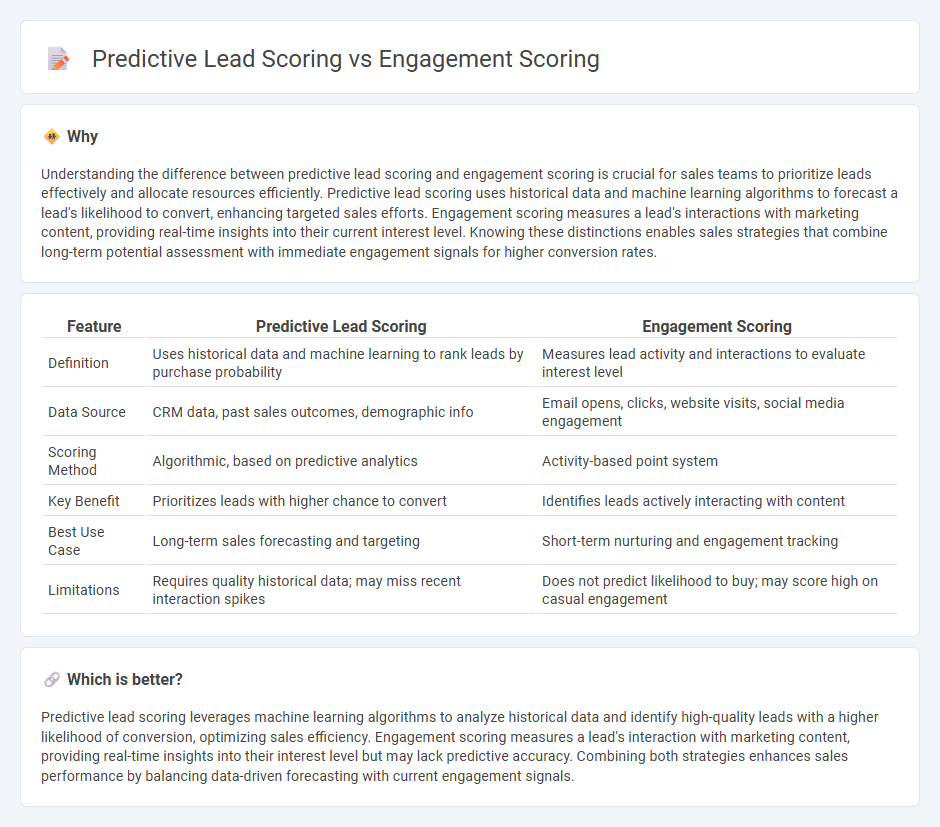
Predictive lead scoring leverages machine learning algorithms and historical data to identify prospects with the highest likelihood to convert, enhancing sales efficiency and prioritization. Engagement scoring measures a lead's interaction and responsiveness with marketing campaigns, offering real-time insights into their current interest levels. Discover how combining these scoring methods can revolutionize your sales strategy and improve conversion rates.
Why it is important
Understanding the difference between predictive lead scoring and engagement scoring is crucial for sales teams to prioritize leads effectively and allocate resources efficiently. Predictive lead scoring uses historical data and machine learning algorithms to forecast a lead's likelihood to convert, enhancing targeted sales efforts. Engagement scoring measures a lead's interactions with marketing content, providing real-time insights into their current interest level. Knowing these distinctions enables sales strategies that combine long-term potential assessment with immediate engagement signals for higher conversion rates.
Comparison Table
| Feature | Predictive Lead Scoring | Engagement Scoring |
|---|---|---|
| Definition | Uses historical data and machine learning to rank leads by purchase probability | Measures lead activity and interactions to evaluate interest level |
| Data Source | CRM data, past sales outcomes, demographic info | Email opens, clicks, website visits, social media engagement |
| Scoring Method | Algorithmic, based on predictive analytics | Activity-based point system |
| Key Benefit | Prioritizes leads with higher chance to convert | Identifies leads actively interacting with content |
| Best Use Case | Long-term sales forecasting and targeting | Short-term nurturing and engagement tracking |
| Limitations | Requires quality historical data; may miss recent interaction spikes | Does not predict likelihood to buy; may score high on casual engagement |
Which is better?
Predictive lead scoring leverages machine learning algorithms to analyze historical data and identify high-quality leads with a higher likelihood of conversion, optimizing sales efficiency. Engagement scoring measures a lead's interaction with marketing content, providing real-time insights into their interest level but may lack predictive accuracy. Combining both strategies enhances sales performance by balancing data-driven forecasting with current engagement signals.
Connection
Predictive lead scoring uses machine learning algorithms to analyze historical data and forecast the likelihood of a lead converting, while engagement scoring measures real-time interactions such as email opens, website visits, and content downloads. Combining predictive lead scoring with engagement scoring enables sales teams to prioritize leads based on both predicted potential and current interest levels, improving conversion rates. This integrated approach streamlines the sales funnel by focusing efforts on prospects with the highest probability of closing.
Key Terms
Engagement Scoring:
Engagement scoring measures a lead's interaction with marketing assets, such as email opens, website visits, and social media activity, providing real-time insights into customer interest levels. This method helps prioritize leads based on current engagement metrics rather than relying solely on historical data or predictive algorithms. Explore how engagement scoring can enhance lead qualification and improve marketing strategies.
Activity Tracking
Engagement scoring quantifies prospect interactions such as email opens, website visits, and social media clicks to gauge interest levels, enabling marketers to tailor follow-up strategies effectively. Predictive lead scoring leverages machine learning algorithms analyzing historical data and activity patterns to forecast a lead's likelihood to convert, enhancing sales prioritization accuracy. Explore advanced activity tracking techniques to optimize both engagement and predictive lead scoring models for maximum ROI.
Interaction Frequency
Engagement scoring measures interaction frequency by tracking actions such as clicks, email opens, and website visits to assess how actively a lead engages with content over time. Predictive lead scoring integrates interaction frequency with demographic and behavioral data to forecast the likelihood of conversion using machine learning algorithms. Discover how combining these scoring methods can maximize sales efficiency and prioritize high-potential leads.
Source and External Links
Engagement Score by WebEngage: The Ultimate Guide - Engagement scores are assigned on a 1-10 scale based on weighted customer interactions, with higher scores indicating greater engagement, and are used for segmentation, targeting, and user analysis.
The Definitive Engagement Score Guide - Pipedrive - Engagement scoring is a customizable metric for measuring involvement across leads, customers, and employees, calculated by assigning points to key actions relevant to your business goals.
What is the Customer Engagement Score? - Refiner.io - A customer engagement score quantifies how users interact with a product in ways that deliver value, using specific, measurable actions as signals of true engagement.
 dowidth.com
dowidth.com